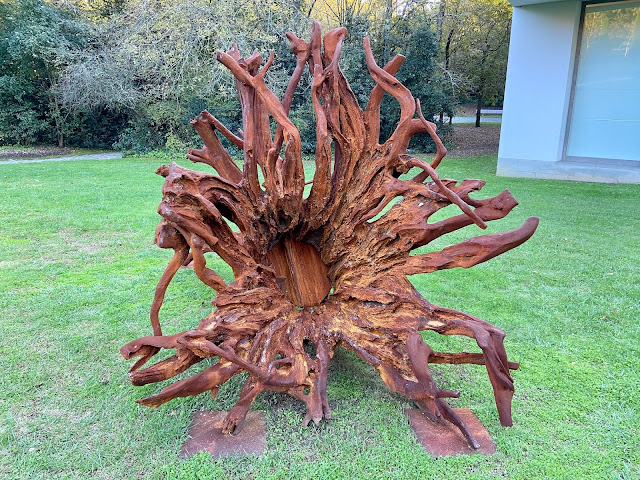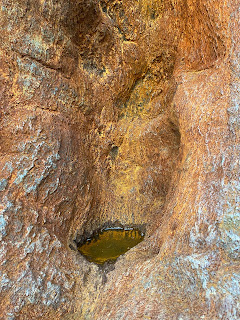Ai Weiwei is showing his 'roots' at the Serralves in Porto. The name of the show is "Intertwine", which is taken from a poem by Ai's father, Ai Qing (Trees, 1940, translated by Peng Wenlan):
One tree, another tree,Each standing alone and erectThe wind and airTell their distance apartBut beneath the cover of earthTheir roots reach outAnd at depths that cannot be seenThe roots of the trees intertwine
The sculptures are a continuation of a series of life-size iron castings of root-balls and other components of trees downed in southern China. The pieces on display at the Serralves are from the Mata Atlántica (Atlantic Forest) of Trancoso in the state of Bahia, Brazil, an area under great threat of deforestation – about six percent of the forest habitat remains from the time of Portugal's arrival, five hundred years ago (Dr Jorge Paiva, "Atlantic Forest", Intertwine show catalog, Serralves, 2021, p 35-37).
His roots are arranged at distances across Serralves Parque, each has a title, which works more as a nickname. The one closest to the entrance is called Voa (Fly, 2019), and leaves no doubt that it is trying to 'reach out' to its siblings, as well as draw the visitors into the journey.
A closer inspection shows the surface textures captured by the molding process. Obviously the sculptures represent trees that have been uprooted, but puddles have formed in the pockets, moss and algae cling to the creases, and spiders are hard at work in the bends. From the entrance, Voa points to two others: Nível (Level, 2019) and Força (Strength, 2019). This trio urges us onto the grass, to examine each one, and the relationships in the group.
While Voa seems to emerge and stretch, Nível looks like a four-legged creature, striding toward the others. Força seems to be more of a tight knot, several elements tied to the ground, pulling themselves up. The three perhaps illustrate several stages of release – but of course, roots that are no longer in the ground are also released from life.
We are witness to interactions that should be underground.
On the other side of the gallery building is Martin (2019), a dynamic and conspicuous assemblage of two discrete root systems that have been tied by bolts and butterfly joints. Walk around to the base of the 'radial' strands, and the intersection is clear: the surface of one trunk is visible in the hollow of the other.
Like two dogs meeting on the street, they may sniff, gently touch, and in the next second, violently bark. It is difficult to determine if their wrestling is playful or in real anger.
At the far end of the formal garden, on the landing that terminates the Parterre Central of the Casa de Serralves, is Palácio (Palace, 2019). Possibly due to the hard surface of the landing, this one seems posed, stretching, as if performing yoga. Again, there are two pieces, but no joinery is needed to fuse the two. Though not presented on a a grassy lawn, Palácio is surrounded by the live trees of the Bosque do Lago.
Past the Lago, and within an area of the Parque called the Prado das Abelhas (bee meadow), we find Festa (Party, 2019) and Sr Pintura (Mr Painting, 2019) framing an open gate. The Prado is a weedy field, fenced from the road, and with a single clean, uphill path. Sr Pintura sits above Festa, both are assemblages, but seem more happily attached, end to end, though there are still bolts and bars holding them fast.
They appear as two-headed animals, connected mid-body, unsure which direction to follow. The leafy ground cover is threatening to reclaim them.
At the end of the path is the Pequi Vinagreiro (Pequi Tree, 2018-20), molded from an actual thirty-two meter tall, twelve hundred year-old, snag in the Brazilian forest. It is hollow, so both sides of the tree needed to be captured. The molding and casting process is documented in a film (A Tree, 2021) which can be viewed in the Museu – a process that occupied Ai and his team for three years.
We slip through the Gothic-lancet openings in the trunk; the tower is open to the sky. The details, meticulously crafted, are endlessly fascinating: burls, knots, cavities in the bark, small scoops and puddles lined with the detritus of life. Among the iron roots and the empty space within, we sense the presence of its living source.
The Pequi Vinagreiro extends skyward, tip-toed, outstretched limbs at its peak. Its roots are planted and hold the earth – but its companions are absent, the connections are absent, the forest is absent. Rigid and anxious, like a Munch painting, the Pequi Vinagreiro delivers an elegy to and of those lost.



























No comments:
Post a Comment